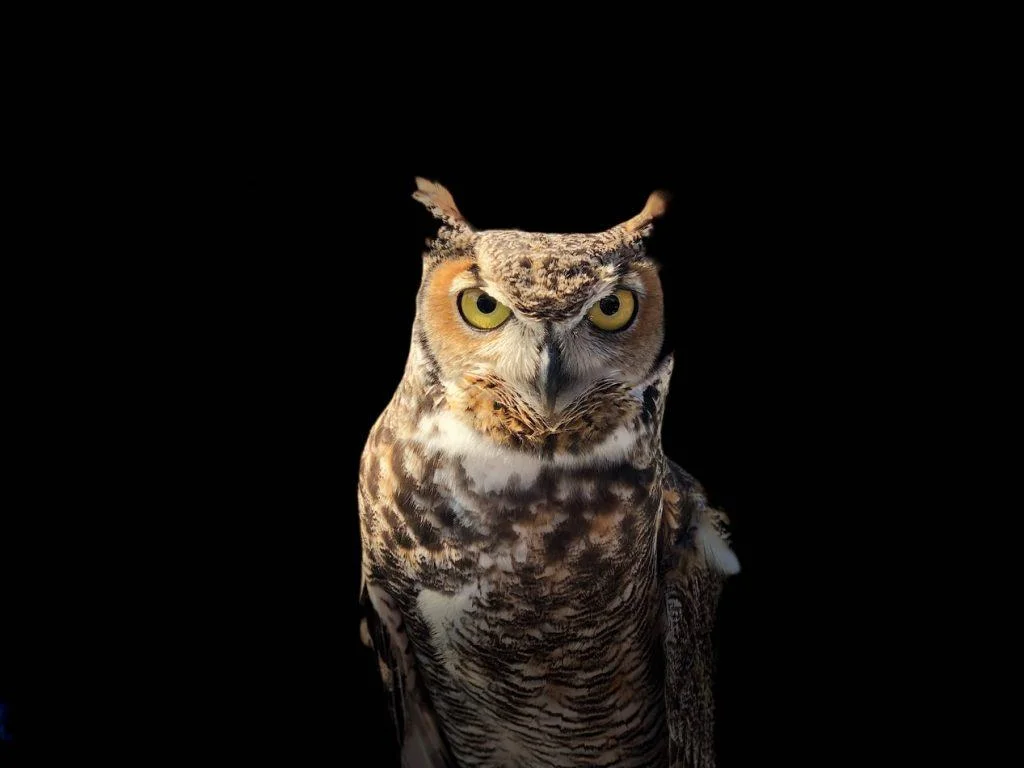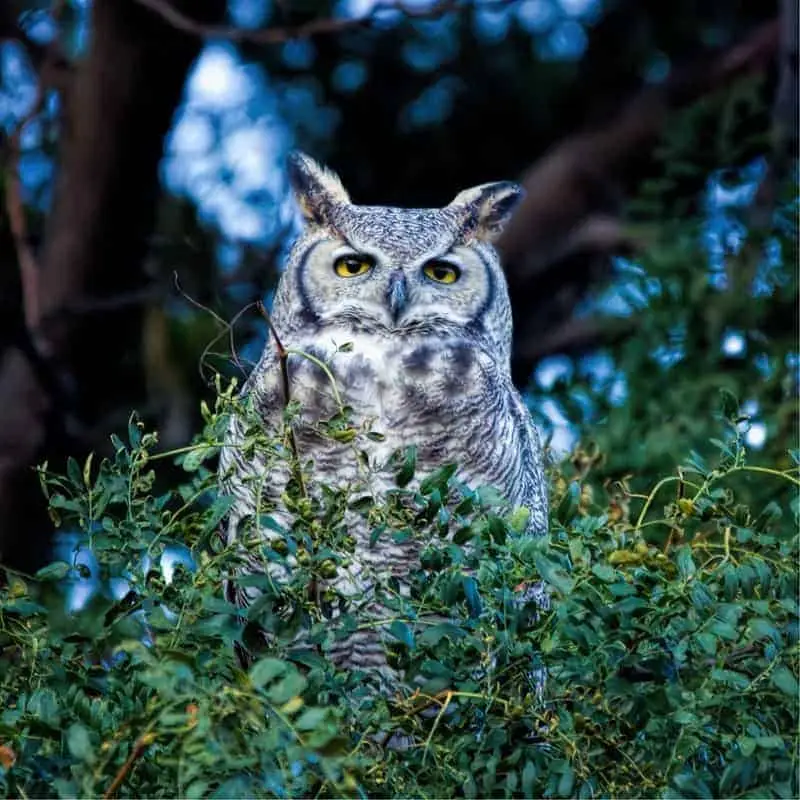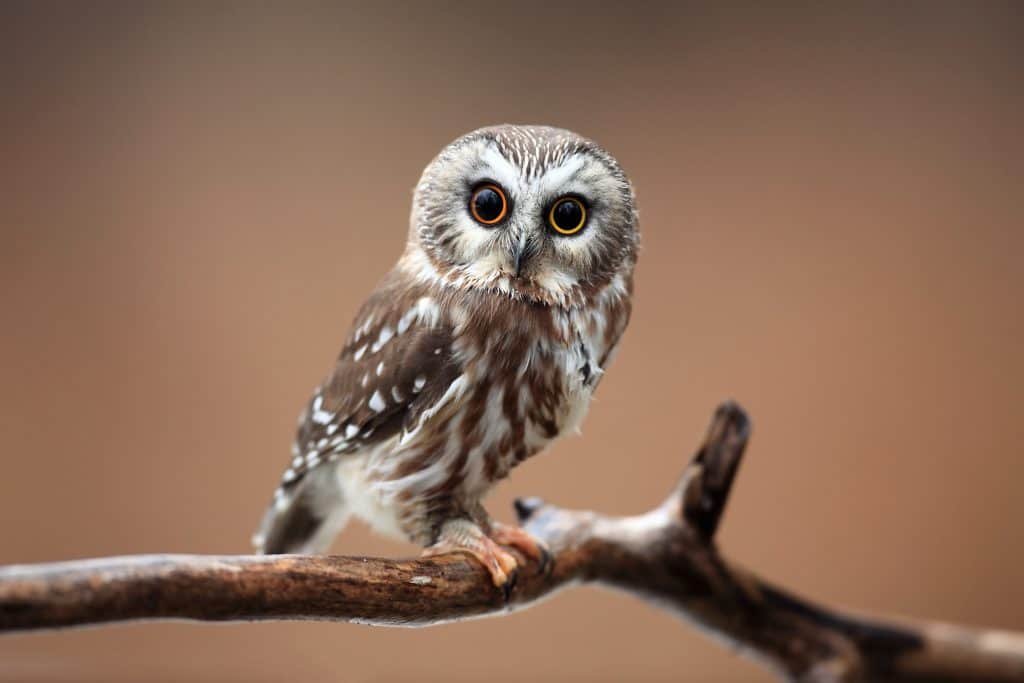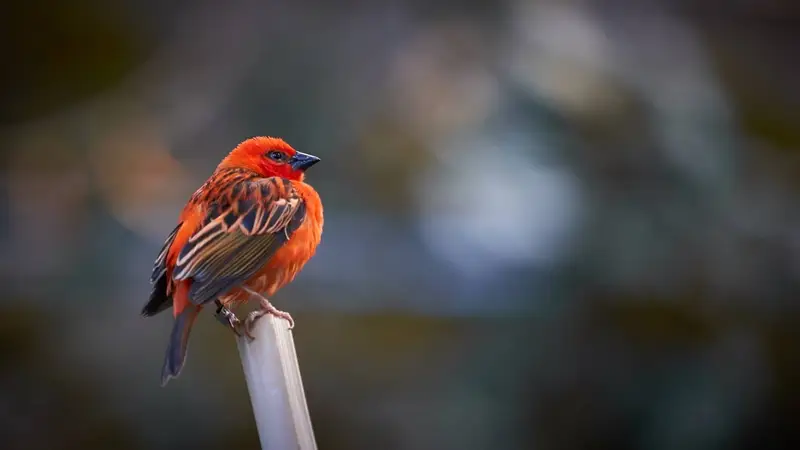
Want to learn more? This National Geographic Book on Owls is a great read!
The most commonly seen of these species in the state is the Great Horned Owl.
Iowa has a continental climate which means that it has four distinct seasons with hot summers and cold winters.
The state has 83 different state park areas and only 2 national parks. These national parks are the Effigy Mounds National Monument and the Herbert Hoover National Historic Site.
After briefly covering the state of Iowa, let’s actually have a look at the nine different owl species that can be seen in the state in more detail.
Want to attract Owls to your yard? Take a look at our article!
What Owls can be seen in Iowa?
Table of Contents
1. Barn Owl

Wingspan
107 to 110 cm
Weight
430 – 620 g
Life Expectancy
Up to 4 years
Diet
Voles, Shrews & Mice
Barn Owls are medium sized owls with pale buff and grey feathers on both the head and their wings.
During the daytime these colours are more noticeable whilst at night and in certain types of light they can appear completely white.
These birds will occasionally stray into southern Canada and can be seen in 48 different states.
You are most likely to see these owls in open country such as grasslands.
These birds are monogamous, and many barn owls appear to mate for life, although there have been some conflicting reports that say males will mate with multiple females.
Males will bring food to the females as she gets the nest ready for incubation. These birds are protective of their nests, but they happily share hunting grounds with others of their species.
With their wide range across the states it is no surprise that the barn owl can be seen in all regions of the state throughout the year.
Most of the recorded sightings of this bird are in the north west of the state and the fewest are in the central regions.
2. Eastern Screech Owl

Wingspan
46 to 61 cm
Weight
160 g
Life Expectancy
14 years
Diet
Rats, Squirrels, Rabbits & Skunks
These birds are very similar in appearance to the Western Screech-Owl, both use their varying grey feathers to camouflage against trees.
These short and stocky owls will form breeding pairs and will help raise young together.
However, some males have been noted to mate with two females throughout the breeding season and they are not believed to form long term breeding pairs.
Males will feed females and their young when they first hatch and spend most of their time defending the nest.
You are most likely to see these birds in dense forests and they have been known to use manmade bird boxes. They have also been known to nest and breed successfully in city parks and farmlands.
The Eastern Screech owl has a range that encompasses the eastern states and they can be seen in Iowa throughout the year.
They can be seen in all regions of the state with most of the sightings being recorded in the north western areas.
3. Great Horned Owl

Wingspan
~140cm
Weight
1.4 kg
Life Expectancy
28 years old
Diet
Squirrels, Rabbits & Skunks
These large owls get their names from their long, pointed ear that look like horns on top of their heads.
They have large stocky bodies with brown and grey feathers. These birds are monogamous and form long term breeding pairs, the breeding pairs have been known to stay with each other outside of the breeding season.
They are territorial birds and have a series of hoots that they will use to defend their territory, both members of the breeding pair will help defend their nests and females tend to be more aggressive than males during the breeding season.
In fact, these birds are so territorial that they have at times been known to kill other individuals of their own species that stray too close to their territory.
They are often harassed by other species of birds such as crows which will call and peck at them to try and get them to abandon the area and their eggs.
As one of the widest spread and most abundant species of owl their range includes all of Iowa and they are year-round residents in the state.
Most of the recorded sightings of this bird have been in the western half of the state.
4. Northern Saw-whet Owl

Wingspan
40 - 60 cm
Weight
100 g
Life Expectancy
7 years
Diet
Small birds, young squirrels, voles & shrews
The Northern Saw-whet Owl is a small species of owl that is covered in dark brown feathers.
These roost throughout the day like most owls and nest in various forests.
Whilst these birds are primarily monogamous, there have been instances of males mating with multiple females during the breeding season.
You will hear their distinct too-too-too mating call from January to March which is the beginning of the breeding season.
When a female enters a male’s territory, he will circle around her in flight 20 times before moving down to her and gifting her with a prey item.
They pair with new mates each year although some breeding pairs will stay with each other to defend their territory outside of the breeding season.
These birds are often preyed upon by larger species of owls.
These birds can be seen throughout the state of Iowa but only outside of their breeding seasons and most commonly in the winter months.
Most of the recorded sightings of this bird have been in the central regions of the state with very few being recorded in the far south of the state.
5. Short-Eared Owl

Wingspan
85 to 110 cm
Weight
206–475 g
Life Expectancy
4-12 years
Diet
Voles, Mice, Squirrels
Short-eared owls are a medium sized species of owl that are covered in brown and white spotted feathers.
These owls prefer to stay in areas of open country and low vegetation and will hunt during both the day and the night.
Short-eared owls form loose colonies and are monogamous maters during the breeding season.
The individuals in the colonies will roost about 50ft away from one another.
It is unknown as to whether they mate for life. Short-eared owls only tend to make their nests in trees during the winter months when it becomes snowy.
They will make their nests close to the ground during the breeding seasons.
Males will feed the females whilst they are incubating the eggs and will also help defend their territory with a series of harsh calls.
These birds can be seen in all regions of Iowa, with some being permanent residents and some only being seen in the state outside of their breeding seasons.
Most of the sightings of this bird appear to be in the eastern half of the state.
6. Snowy Owl

Wingspan
150 cm
Weight
2 kg
Life Expectancy
10 years
Diet
Birds, Rabbits, Fish & Rodents
The Snowy Owl is a large species of owl that is covered in thick white feathers that have tiny grey markings on their tips.
These markings differ between each individual. It is not confirmed whether these birds are monogamous, but it is known that males exhibit a unique flight display when courting a female.
They will grasp some prey, such as a lemming, in their talons before performing a very large dive with their wings in a v shape.
Snowy owls are incredibly aggressive and whilst they are happy to share hunting grounds, they are not happy sharing territories.
There has even been a reported incident of a snowy owl attacking a pair of arctic wolves.
Snowy Owls like wide open spaces with a minimal number of trees, they are most commonly found in tundra habitats and across plains.
They will also perch of high man-made items such as telephone poles during the winter months. This is so that they can observe prey more clearly.
Snowy Owls have a limited range in the United States, but they can be seen in the state of Iowa during the winter months.
There have been sightings of this bird across the state but most of the sightings occur in the northern regions of Iowa.
7. Long Eared Owl

Wingspan
90 to 100cm
Weight
250 g
Life Expectancy
4 years
Diet
Small mammals, mice, rats & rabbits
The Long-Eared Owl, as the name suggests, is known for its long and prominent feathered ears.
Their bodies are covered with black and brown feathers and their faces are orange.
These owls like to roost in dense woodlands and outside of the breeding season will roost in loose colonies of up to 100 individuals.
These colonies stay together for most of the year and even in the breeding season they will nest near each other, but they will not roost together.
These birds are monogamous, only mating with one individual during the breeding season, although it is not believed that they form long term breeding pairs.
Males will court the females by performing a series of complex, zigzag flights whilst producing a mating call.
These birds can be seen throughout all regions of Iowa, but they can only be seen in the state outside of their breeding seasons.
Most of the recorded sightings of this bird are in the central regions of the state with very few in the south west.
8. Burrowing Owl

Wingspan
51-61 cm
Weight
140-240 g
Life Expectancy
10 years
Diet
Large Insects and Small Rodents
The Burrowing Owl is a small species of owl covered in brown feathers and speckled with large amounts of white.
You are most likely to see one of these owls in open, treeless areas of grasslands and they are known to hunt throughout both the day and the night.
Burrowing Owls stay together in loose colonies and are monogamous during the breeding season, although it is unknown as to whether they form long lasting breeding pairs.
As you would likely expect from the name, these owls do make small burrows.
During the breeding season, females will stay in the burrow to incubate the eggs whilst the male defends their territory with a series of calls and wing displays.
These birds are not seen in the state of Iowa outside of their breeding seasons but they can be seen in all regions of the state.
Most of the sightings of this bird have been in the western half of the state.
9. Barred Owl

Wingspan
96-125 cm
Weight
468-1,150 g
Life Expectancy
10-23 years
Diet
Small mammals
Barred Owls are a large and stocky species of owl and they are covered with brown and white barred feathers.
Barred Owls are very territorial and remain so throughout the year, they will make their nests in various types of forests and usually close to bodies of water if they are able.
During the breeding season females appear to be the more aggressive individuals.
They have been observed using a kind of flight attack where they will collide into other birds, talons first.
These birds are monogamous and are believed to mate for life.
They will raise a single brood of eggs together and if there is a predator, one parent will leave the nest to cause a noisy distraction and prevent the young from being attacked.
These birds are year-round residents in the state and can just be seen throughout all regions.
The recorded sightings of this bird are relatively even but there have been most sightings in the southern half of the state.

More Articles.

What Does It Mean To See An Owl During the Day?
Many believe that seeing an owl during the day can have fairly large implications and

Best Hummingbird Feeders for 2020
Nectar bird feeders are well-known for attracting a variety of adorable birds and for saving

How to Attract Finches to Your Yard?
Despite their tiny size, finches are one of the most recognisable birds across the whole

About Us
We are avid bird-watchers who recently retired, allowing us more time to travel the world. Fortunately, we have managed to visit numerous countries around Europe, Asia, and America. Watching and photographing birds has been a passion for many years and we are making the most of the extra time on our hands!
